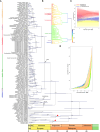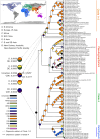Phylogeny, biogeography, and character evolution of Anaphalis (Gnaphalieae, Asteraceae)
- PMID: 38384761
- PMCID: PMC10879626
- DOI: 10.3389/fpls.2024.1336229
Phylogeny, biogeography, and character evolution of Anaphalis (Gnaphalieae, Asteraceae)
Abstract
The HAP clade, mainly including Helichrysum Mill, Anaphalis DC., and Pseudognaphalium Kirp., is a major component of tribe Gnaphalieae (Asteraceae). In this clade, Anaphalis represents the largest genus of Asian Gnaphalieae. The intergeneric relationships among Anaphalis and its related genera and the infrageneric taxonomy of this genus are complex and remain controversial. However, there are few studies that have focused on these issues. Herein, based on the current most comprehensive sampling of the HAP clade, especially Anaphalis, we conducted phylogenetic analyses using chloroplast (cp) genome and nuclear ribosomal DNA (nrDNA) to evaluate the relationships within HAP clade, test the monophyly of Anaphalis, and examine the infrageneric taxonomy of this genus. Meanwhile, the morphological characters were verified to determine the circumscription and infrageneric taxonomy system of Anaphalis. Additionally, the biogeographical history, diversification processes, and evolution of crucial morphological characters were estimated and inferred. Our phylogenetic analyses suggested that Anaphalis is polyphyletic because it nested with Helichrysum and Pseudognaphalium. Two and four main clades of Anaphalis were identified in cp genome and nrDNA trees, respectively. Compared with nrDNA trees, the cp genome trees were more effective for phylogenetic resolution. After comprehensively analyzing morphological and phylogenetic evidence, it was concluded that the achene surface ornamentation and leaf base showed less homoplasy and supported the two Anaphalis lineages that were inferred from cp genome. Our biogeographical analyses based on cp genome indicated that HAP clade underwent rapid diversification from late Miocene to Pliocene. The two Anaphalis lineages appeared to have originated in Africa, then spread to Western and Southern Asia, and subsequently moved into Southwestern China forming a diversity center. The dispersal patterns of the two Anaphalis lineages were different. One dispersed around the world, except in Africa and South America. The other one dispersed to Eastern and Southeastern Asia from the ancestral origin region.
Keywords: Anaphalis; Asteraceae; Gnaphalieae; biogeography; molecular phylogenetic.
Copyright © 2024 Xu, Xu, Yang, Wei, Gu, Liu, Liu and Zhu.
Conflict of interest statement
The authors declare that the research was conducted in the absence of any commercial or financial relationships that could be construed as a potential conflict of interest.
Figures





Similar articles
-
Molecular phylogeny of Anaphalis (Asteraceae, Gnaphalieae) with biogeographic implications in the Northern Hemisphere.J Plant Res. 2013 Jan;126(1):17-32. doi: 10.1007/s10265-012-0506-6. Epub 2012 Jul 10. J Plant Res. 2013. PMID: 22776917
-
Climatic oscillations, dispersibility and adaptability behind worldwide mountain radiations of the Helichrysum- Anaphalis-Pseudognaphalium (HAP) clade (Compositae).Ann Bot. 2025 May 31:mcaf110. doi: 10.1093/aob/mcaf110. Online ahead of print. Ann Bot. 2025. PMID: 40447279
-
Plastid genomes provide insights into the phylogeny and chloroplast evolution of the paper daisy tribe Gnaphalieae (Asteraceae).Gene. 2024 Apr 5;901:148177. doi: 10.1016/j.gene.2024.148177. Epub 2024 Jan 18. Gene. 2024. PMID: 38242378
-
The complete chloroplast genome sequence of Anaphalis margaritacea var. yedoensis (Asteraceae) and phylogenetic relationships within Gnaphalieae.Mitochondrial DNA B Resour. 2022 Apr 1;7(3):563-565. doi: 10.1080/23802359.2022.2048213. eCollection 2022. Mitochondrial DNA B Resour. 2022. PMID: 35386960 Free PMC article.
-
Phylogenetic Review of Acaulospora (Diversisporales, Glomeromycota) and the Homoplasic Nature of Its Ornamentations.J Fungi (Basel). 2022 Aug 23;8(9):892. doi: 10.3390/jof8090892. J Fungi (Basel). 2022. PMID: 36135617 Free PMC article. Review.
References
-
- Abid R., Qaiser M. (2007). Cypsela morphology of the genus Anaphalis DC. (Gnaphalieae-Asteraceae) from Pakistan. Pak. J. Bot. 39, 1897–1906.
-
- Anderberg A. A. (1991). Taxonomy and phylogeny of the tribe Gnaphalieae (Asteraceae). Opera Bot. 104, 1–195.
-
- Andrés-Sánchez S., Verboom G. A., Galbany-Casals M., Bergh N. G. (2019). Evolutionary history of the arid climate-adapted Helichrysum (Asteraceae: Gnaphalieae): Cape origin and association between annual life-history and low chromosome numbers. J. Syst. Evol. 57, 468–487. doi: 10.1111/jse.12472 - DOI
LinkOut - more resources
Full Text Sources
Miscellaneous

